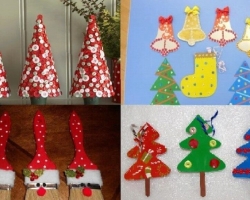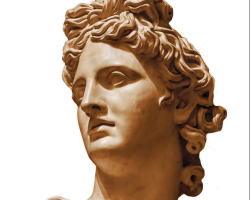In this topic, we offer a cracked master class.
Content
Zhduna we attribute to almost all aspects of our lives. The famous sculpture, which grew into a popular meme of the Internet, is easily embodied in a small copy. And you can do this with a hook. Therefore, we offer a detailed description of how to crochet Zhdun, and please our relatives.
How to crochet Zhduna: Start from the body
For a toy of 15 cm high, 400 m or 100 g of gray yarn. For her, select the hook number 2.
- Knitting begins From the ring of amigurumi.That is, cross the thread into the loop, create a column from the upper thread and knit 6 tbsp from the middle of this ring. b/n. Below we offer a diagram of how this manipulation is performed. In conclusion, tighten the thread.

- The second row doubles the circle. Therefore, accordingly, we knit 12 tbsp. b/n.
Important: the work is based on a crochet columns! Otherwise, the toy could not have been so good. Therefore, in the future we will use Art. And half -steam., which will imply elements without crochet.
- After you act according to the scheme:
- knit in the 3rd row for 2 tbsp. In every second Petel. That is, after 1 column. As a result, 18 loops should turn out;
- in the 4th row, you also do 2 tbsp., but already After 2 columns. That is, in 3 loop. As a result, get 24 loops;
- 5 row - In every fourth column. And get 30 loops;
- in the 6th row, we make an increase (2 loops) already After 4 loops. That is, in every 5 loop and we get 36 loops;
- in the 7th row - After 5 loops. We get 42 loops;
- 8 row is coming After 6 loops Or in every 7 stitch. As a result, there should be 48 turns;
- 9 row - In every 8 loop. In total, 54 loops come out, which create a flat circle;
- 10 row - 2 tbsp. Every 8 loops. As a result, we get 60 loops;
- In the 11th row, we should have 66 loops using the increase every 9 loops;
- 12 row has 72 loops and increase in every 11 loop;
- 13 row - 2 tbsp. In every 12 loop. And we get 78 loops;
- The final 14 row has an increase After 12 loops, And in the end we have 84 turns.

- Subsequent rows from 15 to 20 go for a circular rise. Therefore, we tie them, not evasing and not reducing the number of loops - 84 columns.
- now we We work for decrease. But it is advisable to make it a secret or invisible method. That is, you need to pass the hook by the lower threads of the loops (in the figure they are depicted green and red). And immediately knit one loop from them. Although you can use a simple decrease scheme, as we provided below in the photo.

- Our 21 -row will have a mirror decrease - After 12 loops, Five times. As a result, we get 79 loops, but first we knit 14 tbsp.
- 22 row is coming, respectively, with decrease After 11 loops. We get 74 loops, at the beginning of the row we also knit 14 loops.
- We start 23 row with 30 tbsp. and do 4 decreases After the next 10 loops. As a result, we get 70 loops.
- In the 24th row through the first 26 tbsp. We make a decrease and continue the reduction after 5 loops. As a result, we get 63 loops.
- Next, we knit 3 rows unchanged 63 tbsp.
- On the 28 row we begin to form the first fold. To do this, divide the zone into three parts. Our back is without folds and goes without decreases. Visually, it looks flat. We need to divide the stomach in half. You can do this with a thread or pins.
Important: each of these marked segments should be the same and even. Therefore, for verification, fold each site, which was marked with pins, among themselves.
- Now you need to knit 24 tbsp. b/n and 39 more loops Behind the back wall! At the same time, keep in mind that by the marker we mark the beginning of our folds.
Important: we offer a simpler option when you do not need to sew folds. But they will not turn out so voluminous. If it is important for you to have large folds, then tie up to 35 rows, wrap at the level of 28 rows and go to the bent edge with the appropriate color.

- In the 29th row we do 4 tbsp. b/n For the back wall, And the next 59 - just columns.
- The 30th row is already responsible for fastening the fold. It is necessary to knit 24 tbsp. The next 39 columns should capture those front walls of 39 loops from 28 rows, which were knitted behind the back wall.
- 31 row has a more complex scheme: 4 tbsp. beyond the wall of the previous row, When we knitted loops by the back wall in the 29th row. We do 25 tbsp. b/n, decrease, 29 more loops, decrease and 1 tbsp.
- Three rows we knit on 61 loops unchanged.
- We continue to make folds with a narrowing of the body. We make a decrease, 28 tbsp., 2 together and another 29 tbsp., But already Behind the back wall.
- 36 row we go without a change in 59 loops.

- We also start 36 row with decrease, 26 tbsp., Reducing and do 29 loops For the front wall of 35 rows.
- We knit 57 loops unchanged.
- A similar scheme with decrease continues: Ubal., 26 tbsp., Udbaval. And already 27 tbsp. b/n.
- In the 40th row we knit 55 loops.
- 41 row - we make the first decrease and repeat it after 24 loops, close the next 7 loops in the usual way.
- 42 row has a similar decrease scheme through 23 loops. Close a row 26 tbsp. Behind the back wall.
- In the 43rd we have 49 loops: Ubal., 22 tbsp., Ubl., 25 tbsp.
- In the 44th row, we form another fold - Ubl., 19th century, Ubl., 26 tbsp. For the front wall of 42 rows.
- 45 row - Ubl., 19th century, Ubl., 22 tbsp. And another decrease.
- 46 row - 21 tbsp., Ubl., And cover the remaining 21 loops.
- 47 row - Ubl., 17 tbsp., Ubl., 10 loops, Ubloval. And another 10 tbsp. It has 47 loops.

- In the 48th row, the formation of the openings of the hands is being formed. 9 tbsp., 2 tbsp. from one loop (increase), 4 c. p., missing 4 loops. We knit on the back 15 tbsp. And again we repeat the opening of the 4th century. n. and 4 missed loops. Now the marker must be moved 2 loops forward.
- 49 row begins with 21 tbsp., Utabli, 5 tbsp., Ubl., 4 tbsp. And another decrease. Close the remaining 5 loops. Keep in mind that it is necessary to knit on the back wall in air hinges! 38 loops come out.
- 50 row - 17 tbsp., Ubl., 2 tbsp., Udbavl., 9 tbsp., Ubloval and again 2 tbsp., Ubl. As a result, 34 loops.
- 51 row - Ubl., 13 tbsp., Ubl., 7 tbsp., Ubl., 8 tbsp. As a result, we get 31 loop.
- The final 52 row consists of Ubal., 11 tbsp., Udbavl., 7 tbsp., Ubl., 7 tbsp. - 28 loops.
Important: Do not cut off the thread! For convenience, we continue to knit hands, and then close the work with your head.
In conclusion, almost to the top, we stuff the toy with synthetic winterizer. For convenience, after linking your hands, add the remaining necessary part of the filler.
Video: how to tie a jerk - make a body
How to tie the hands of Zhdun?
It does not matter which hand you start. In fact, the principle of knitting remains unchanged. The only thing, follow the mirror position.
- In the middle of the lower armhole we attach the thread. We begin to knit 2 tbsp., We climb into the side by 2 loops, pass on top of 4 tbsp., We go down 2 loops down, and close our row 2 tbsp into the ring.
- The next 11 rows we knit without change - 12 loops!

- In 12 and 13 rows We make an elbow. To do this, after 12 tbsp. We make 2 half -stroke. C/n from one loop, 12 tbsp. b/n. In the 13th row, a similar scheme, but we remove these semi -stolks with ordinary decrease. That is, we knit them together.
- 14-15 row-unchanged, 12 tbsp.
- In the 16th row we do 1 decrease.
- 17 row unchanged, 11 loops.
- From 18 to 20 row - we do 1 decrease.
- 22 row already forms a palm, Therefore, we begin with an increase, 3 tbsp., 2 tbsp. From one loop and another 3 tbsp.
- In the 23rd row we make an increase, with which we start, after 4 tbsp. And at this stage we form a thumb of the 3rd century. n. and 2 connecting columns, which we remove from the second from the hook of the loop.
- In the 24 row we knit 11 tbsp., And 12 columns We take out the thumb, On the other side of the palm.
- In the 25th row, we form all other fingers. Please note That on the right hand we start from the index finger to the little finger, and on the left - we work the other way around.
- We make fingers from the 4th century. n., In the second, from the hook, we introduce 3 connecting posts. At the same time, keep in mind that they must be drawn through both edges of the palm. The little finger is given according to the same scheme, but out of the 3rd century. P.
In conclusion, we fill them with a synthetic winterizer for very little, helping yourself with a rod of the handle, and insert the wire.

We knit the head of the Zhdun
- We tie a new thread to the body and knit 28 tbsp.
- We make a decrease, repeat it after 10 tbsp. We tie the remaining 14 loops.
- We knit 26 loops without changing.
- We make a decrease again and repeat it after 8 loops. We also close 14 tbsp.
- In the 5th row of the head, we knit 22 tbsp. And we close the two loops together.
- 6 row - 10 tbsp., Ubl., 11 tbsp. As a result, we get 22 loops.
- In the 7th row we begin to form the nose - 14 tbsp., 8 c. n., Passing only 6 loops, we close 2 tbsp. b/n. We get 24 loops.
- We form eyebrows for the eyes: 3 half. In one loop, Ublovl., 6 tbsp., Udbavl., again 3 is half a half. In one loop. Next, we knit according to the scheme: Ubl., Art. Until the end of the row, completing the decrease. As a result, we have 22 loops.
- Close 3 loops together behind the back wall of half a steel, * decrease., Art., Udbavl., Art., Uda, * again 3 loops together behind the rear walls of the half -stands. Next, repeat from and to stars (*). We knit on the back wall through air hinges. As a result, we get 12 loops.
- In the overestimated row we immediately make 6 decreases. At the same time, we knit them tightly and well tighten them with thread!
At this stage, we stuff your head through the nose.

We knit the nose of the Zhdun
We fasten the thread to the left of the middle.
- We go according to the approximate scheme, as with the hands: 3 loops below, rises from the side of 1 tbsp., 8 loops from above, lower to 1 loop and close in the circle of 3 tbsp.
- The second row is 5 tbsp., Ubl., 2 tbsp., Ubl., 5 tbsp. We have 14 loops.
- 3 row - 3 tbsp., 2 tbsp. From one loop, 6 tbsp., Again 2 tbsp. From one loop and we complete 3 tbsp.
- In the 4th row, also We make an increase in the nose: 4 tbsp., Addition of 2 tbsp., 8 tbsp., Add, 2 tbsp. As a result, we get 18 loops.
- In the 5th row is already going on Nasal reduction: 6 tbsp., Ubl., 4 tbsp., Ubl., 4 tbsp.
- The 6th row begins with a column and decrease. We continue 3 more times 2 tbsp., Ubl. As a result, we get 12 loops.
- We knit 7 row unchanged.
- 8 row - 3 tbsp., Ubl., 4 tbsp., Udbaval. And close the last column.
- The 9th row is knitted according to the scheme of 3 tbsp., Reducing. As a result, 8 loops should be released.

Now we also stuff the nose a little. But we are not fond of, because it needs to be tilted and sewn to the neck. To do this, use the remaining thread from the yarn. Eyes require special attention - they should be sewn under the edge, while tightening the face slightly in width.
Note: For a greater effect, you can slightly tint the folds with gray or black pencil.







